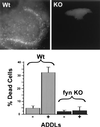Diffusible, nonfibrillar ligands derived from Abeta1-42 are potent central nervous system neurotoxins
- PMID: 9600986
- PMCID: PMC27787
- DOI: 10.1073/pnas.95.11.6448
Diffusible, nonfibrillar ligands derived from Abeta1-42 are potent central nervous system neurotoxins
Abstract
Abeta1-42 is a self-associating peptide whose neurotoxic derivatives are thought to play a role in Alzheimer's pathogenesis. Neurotoxicity of amyloid beta protein (Abeta) has been attributed to its fibrillar forms, but experiments presented here characterize neurotoxins that assemble when fibril formation is inhibited. These neurotoxins comprise small diffusible Abeta oligomers (referred to as ADDLs, for Abeta-derived diffusible ligands), which were found to kill mature neurons in organotypic central nervous system cultures at nanomolar concentrations. At cell surfaces, ADDLs bound to trypsin-sensitive sites and surface-derived tryptic peptides blocked binding and afforded neuroprotection. Germ-line knockout of Fyn, a protein tyrosine kinase linked to apoptosis and elevated in Alzheimer's disease, also was neuroprotective. Remarkably, neurological dysfunction evoked by ADDLs occurred well in advance of cellular degeneration. Without lag, and despite retention of evoked action potentials, ADDLs inhibited hippocampal long-term potentiation, indicating an immediate impact on signal transduction. We hypothesize that impaired synaptic plasticity and associated memory dysfunction during early stage Alzheimer's disease and severe cellular degeneration and dementia during end stage could be caused by the biphasic impact of Abeta-derived diffusible ligands acting upon particular neural signal transduction pathways.
Figures





Similar articles
-
Blocking the Interaction between EphB2 and ADDLs by a Small Peptide Rescues Impaired Synaptic Plasticity and Memory Deficits in a Mouse Model of Alzheimer's Disease.J Neurosci. 2016 Nov 23;36(47):11959-11973. doi: 10.1523/JNEUROSCI.1327-16.2016. J Neurosci. 2016. PMID: 27881781 Free PMC article.
-
The Ginkgo biloba extract EGb 761 rescues the PC12 neuronal cells from beta-amyloid-induced cell death by inhibiting the formation of beta-amyloid-derived diffusible neurotoxic ligands.Brain Res. 2001 Jan 19;889(1-2):181-90. doi: 10.1016/s0006-8993(00)03131-0. Brain Res. 2001. PMID: 11166702
-
Why Alzheimer's is a disease of memory: the attack on synapses by A beta oligomers (ADDLs).J Nutr Health Aging. 2008 Jan;12(1):51S-7S. doi: 10.1007/BF02982587. J Nutr Health Aging. 2008. PMID: 18165846 Review.
-
Abeta oligomer-induced aberrations in synapse composition, shape, and density provide a molecular basis for loss of connectivity in Alzheimer's disease.J Neurosci. 2007 Jan 24;27(4):796-807. doi: 10.1523/JNEUROSCI.3501-06.2007. J Neurosci. 2007. PMID: 17251419 Free PMC article.
-
Vicious cycles within the neuropathophysiologic mechanisms of Alzheimer's disease.Curr Alzheimer Res. 2006 Apr;3(2):95-108. doi: 10.2174/156720506776383068. Curr Alzheimer Res. 2006. PMID: 16611010 Review.
Cited by
-
Influence of the physiochemical properties of superparamagnetic iron oxide nanoparticles on amyloid β protein fibrillation in solution.ACS Chem Neurosci. 2013 Mar 20;4(3):475-85. doi: 10.1021/cn300196n. Epub 2013 Jan 23. ACS Chem Neurosci. 2013. PMID: 23509983 Free PMC article.
-
Nanodiscs as a new tool to examine lipid-protein interactions.Methods Mol Biol. 2013;974:415-33. doi: 10.1007/978-1-62703-275-9_18. Methods Mol Biol. 2013. PMID: 23404286 Free PMC article. Review.
-
Multivariate analyses of amyloid-beta oligomer populations indicate a connection between pore formation and cytotoxicity.PLoS One. 2012;7(10):e47261. doi: 10.1371/journal.pone.0047261. Epub 2012 Oct 15. PLoS One. 2012. PMID: 23077580 Free PMC article.
-
Amyloid-β peptide protects against microbial infection in mouse and worm models of Alzheimer's disease.Sci Transl Med. 2016 May 25;8(340):340ra72. doi: 10.1126/scitranslmed.aaf1059. Sci Transl Med. 2016. PMID: 27225182 Free PMC article.
-
Innovative Therapeutic Strategies in Alzheimer's Disease: A Synergistic Approach to Neurodegenerative Disorders.Pharmaceuticals (Basel). 2024 Jun 6;17(6):741. doi: 10.3390/ph17060741. Pharmaceuticals (Basel). 2024. PMID: 38931409 Free PMC article. Review.
References
Publication types
MeSH terms
Substances
LinkOut - more resources
Full Text Sources
Other Literature Sources
Miscellaneous

